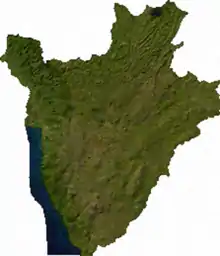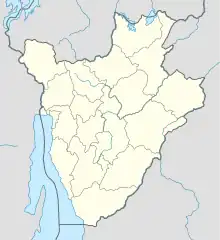Geography of Burundi
Burundi is located in East Africa, to the east of the Democratic Republic of the Congo, at the coordinates 3°30′S 30°0′E.
  | |
| Continent | Africa[1] |
|---|---|
| Region | East Africa |
| Coordinates | 3°30′S 30°0′E |
| Area | Ranked 142nd |
| • Total | 27,830 km2 (10,750 sq mi) |
| • Land | 92.2% |
| • Water | 7.8% |
| Coastline | 0 km (0 mi) |
| Borders | 1,140 km (DRC 236 km, Rwanda 315 km, Tanzania 589 km) |
| Highest point | Mount Heha 2684 m |
| Lowest point | Lake Tanganyika 772 m |
| Longest river | Ruvubu 300 km |
| Largest lake | Lake Tanganyika |




Physical geography
Burundi occupies an area equal to 27,830 square kilometres (10,750 sq mi) in size, of which 25,680 square kilometres (9,920 sq mi) is land. The country has 1,140 kilometres (710 mi) of land border: 236 kilometres (147 mi) of which is shared with the Democratic Republic of the Congo, 315 kilometres (196 mi) with Rwanda and 589 kilometres (366 mi) with Tanzania. As a landlocked country, Burundi possesses no coastline. It straddles the crest of the Congo-Nile Divide which separates the basins of the Congo and Nile rivers. The farthest headwaters of the Nile, the Ruvyironza River, has its source in Burundi.
Terrain

The terrain of Burundi is hilly and mountainous, dropping to a plateau in the east. The southern and eastern plains have been categorised by the World Wide Fund for Nature as part of the Central Zambezian miombo woodlands ecoregion.
The lowest point in the country is at Lake Tanganyika, at 772 metres (2,533 ft), with the highest point being on Mount Heha, at 2,684 metres (8,806 ft).[2] Natural hazards are posed in Burundi by flooding and landslides.
Natural resources
Burundi possesses reserves of: nickel, uranium, rare earth oxides, peat, cobalt, copper, platinum (not yet exploited), vanadium, niobium, tantalum, gold, tin, tungsten, kaolin, and limestone. There is also arable land and the potential for hydropower. Burundi has 214.3 square kilometres (82.7 sq mi) of land that is irrigated. The table below describes land use in Burundi.
| Use | Percentage of Area |
|---|---|
| arable land | 42.83 |
| permanent crops | 13.63 |
| other | 43.54 |
Climate
The climate of Burundi is equatorial in nature and is marked by high mean annual temperatures, small temperature ranges, and rainfall throughout the year.[3] The temperature and amount of rainfall varies dependent upon altitude.[4] Burundi experiences its dry season between May and August, and its rainy season between February and May.[4] Due to climate change, Burundi is becoming more susceptible to both excess and deficit rainfall, leading alternately to floods and droughts.[5]
Environment
Current issues
Soil erosion is an issue for Burundi, and is as a result of overgrazing and the expansion of agriculture into marginal lands. Other issues include: deforestation, due to the uncontrolled cutting-down of trees for fuel; and habitat loss threatens wildlife populations.
International agreements
Burundi is a party to the following international agreements that relate to the environment: Biodiversity, Climate Change, Desertification, Endangered Species, Hazardous Wastes and Ozone Layer Protection. The following have been signed but not yet ratified by Burundi: Law of the Sea and Nuclear Test Ban.
Extreme points
This is a list of the extreme points of Burundi, the points that are farther north, south, east or west than any other location.
- Northernmost point – Muyinga Province; unnamed location on the border with Rwanda immediately south of the Rwandan town of Mbuye
- Easternmost point – Cankuzo Province; unnamed location on the border with Tanzania immediately northwest of Mburi hill
- Southernmost point – Makamba Province; unnamed location on the border with Tanzania immediately north of the Tanzanian town of Mwenene,
- Westernmost point – Cibitoke Province; unnamed location on the border the Democratic Republic of the Congo immediately east of the Congolese town of Kamanyola
References
![]() This article incorporates public domain material from The World Factbook. CIA.
This article incorporates public domain material from The World Factbook. CIA.
- "CIA World Factbook". 15 November 2022.
- "Burundi, land and resources".
- McKnight, Tom L.; Hess, Darrel (2000). Physical geography: a landscape appreciation (6th ed.). Upper Saddle River: Prentice Hall. pp. 205–208. ISBN 0-13-020263-0.
- Baramburiye, Juvent; Kyotalimye, Miriam; Thomas, Timothy S.; Waithaka, Michael (2013). "Burundi". In Waithaka, Michael; Nelson, Gerald C.; Thomas, Timothy S.; Kyotalimye, Miriam (eds.). East African agriculture and climate change: a comprehensive analysis. Washington, D. C.: International Food Policy Research Institute. pp. 55–87.
- Naumann, G.; Barbosa, P.; Garrote, L.; Iglesias, A.; Vogt, J. (6 May 2014). "Exploring drought vulnerability in Africa: an indicator based analysis to be used in early warning systems". Hydrology and Earth System Sciences. 18 (5): 1591–1604 – via Copernicus Publications.